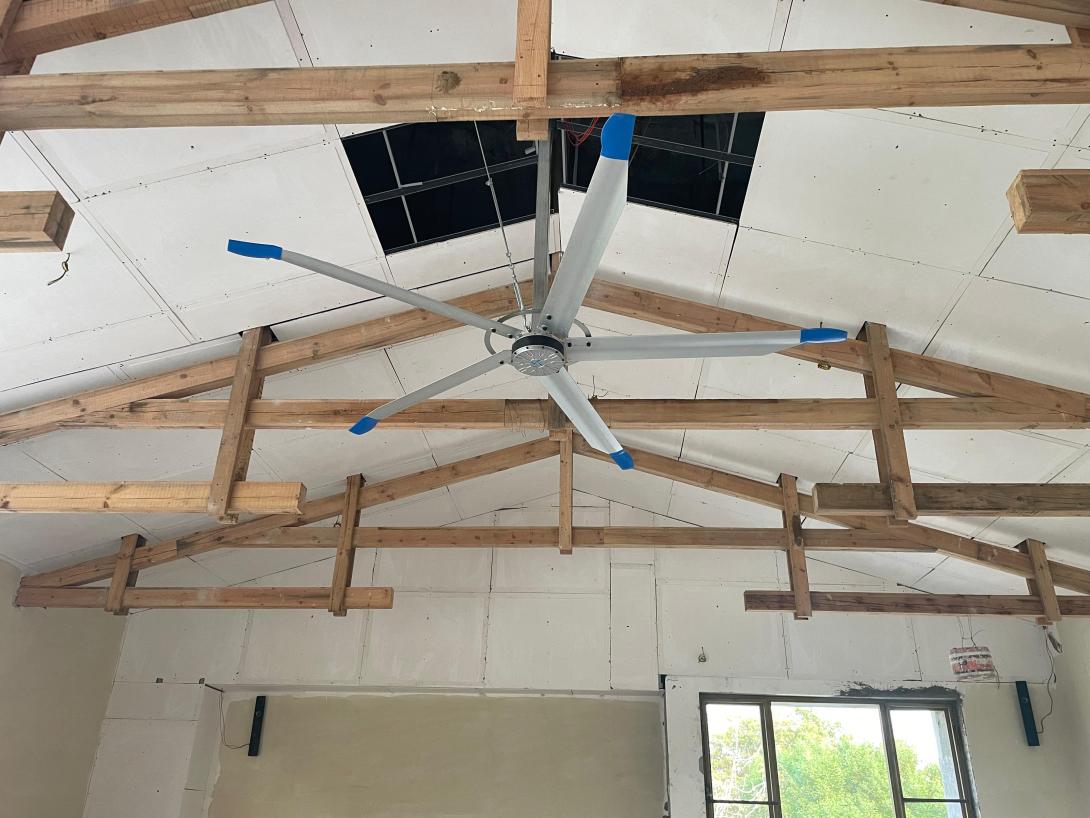
With the rapidly changing business environment today, employee well-being and productivity have become priority issues for businesses across sectors. With companies seeking to provide healthier and more pleasant indoor spaces, indoor air quality (IAQ) has taken on a high priority. Inadequate air quality can contribute to health problems, discomfort, loss of focus, and absenteeism, affecting performance and morale dramatically.
One of the technologies that is showing its mettle as a force to be reckoned with in the improvement of IAQ and promoting employee health is the High Volume, Low Speed (HVLS) fan. The big-diameter fans are revolutionizing workplace airflow management, comfort, and health — earning them a top spot in contemporary facility design and management.
What Are HVLS Fans?
HVLS fans are big, ceiling-suspension fans that are usually between 7 and 24 feet in diameter. In contrast to conventional fans, HVLS fans rotate slowly but move an enormous quantity of air — that is how they got their name. Their main purpose is to move the air better and in a uniform manner over a big space.
Rather than producing a concentrated, narrow airflow like smaller fans, HVLS fans quietly circulate air throughout an entire space, producing a more uniform indoor climate. This has far-reaching implications for comfort and air quality.
The Link Between IAQ and Employee Health
Indoor air quality is generally affected by indoor pollutants like dust, mold spores, volatile organic compounds (VOCs), carbon dioxide, and bacteria. These pollutants tend to concentrate in poorly ventilated areas, particularly in structures with poor HVAC systems or limited air flow.
Poor IAQ can lead to complaints like headaches, fatigue, eye irritation, and respiratory difficulties — commonly known as "sick building syndrome." Long-term exposures can produce more severe health effects, including asthma and other chronic respiratory diseases, over time.
By improving airflow and diluting pollutant concentrations, employers can achieve a healthier indoor environment that keeps these risks at bay. This is where HVLS fans enter the scene.
How HVLS Fans Improve Indoor Air Quality
1. Enhanced Air Circulation
HVLS fans enhance IAQ mostly through better air circulation. Large blades with these fans push air slowly but with high efficiency, disrupting stagnant areas and distributing fresh air more evenly. Constant circulation keeps airborne pathogens in motion, diluting them and minimizing concentrations of pollutants within any one zone.
2. Better Ventilation Synergy
When combined with HVAC systems, HVLS fans aid in the distribution of conditioned air more evenly throughout a building. This decreases the HVAC system load, enables more stable temperatures, and encourages regular indoor/outdoor air exchange. It's particularly useful in big structures like warehouses, factories, gymnasiums, and open-plan offices.
3. Humidity and Mold Control
Stagnant, humid spaces are breeding grounds for mildew and mold, both of which are significant IAQ threats. HVLS fans assist in managing indoor humidity by circulating air, avoiding condensation, and evaporating moisture-susceptible areas. This can be important in sustaining hygienic conditions in areas such as food processing zones or humid climates.
4. Energy-Efficient Fresh Air Management
Conventional HVAC systems usually are challenged to sustain comfort against energy usage, especially when ventilation rates are being raised. HVLS fans complement these systems by enhancing the efficiency of fresh air distribution without the use of energy-hungry means. This minimizes the requirement for over-conditioning the air, decreasing energy expenses while sustaining very high levels of IAQ.
Employee Health and Productivity Benefits
A healthier space isn't only better for the lungs — it's better for the bottom line.
- Less Sick Leave: Cleaner air decreases respiratory illnesses, allergies, and contagious illness, which causes fewer absences.
- Better Cognitive Performance: A lot of research indicates that good IAQ boosts concentration, decision-making, and cognitive performance.
- Increased Comfort and Morale: Temperature control and less stuffiness lead to a more comfortable work environment, increasing employee morale and productivity.
- Compliance with Health Standards: Several industries are required to comply with indoor air quality standards (e.g., OSHA, ASHRAE). HVLS fans can contribute to compliance with these standards affordably.
Use Cases Across Industries
HVLS fans are gaining acceptance in a variety of settings where indoor air quality and worker comfort are important:
- Manufacturing Plants: Enhance airflow in high-ceiling areas with heat and chemical releases.
- Warehouses and Distribution Centers: Avoid temperature stratification and boost ventilation.
- Office Buildings: Enhance HVAC support and minimize stuffiness in open-plan spaces.
- Gyms and Fitness Centers: Freshen the air and minimize sweat-induced humidity.
- Agricultural Facilities: Minimize dust, odors, and allergens carried by animals.
A Smart Investment for the Future
As companies increasingly put a focus on employee health, solutions such as HVLS fans provide a proactive answer to indoor air quality issues. They are more than mere fans — they are a strategic choice in office health, energy savings, and regulatory adherence.
As awareness surrounding airborne sickness, allergy, and office wellness increases, facilities which install HVLS fans will be more capable of designing spaces in which employees will thrive.
Conclusion
Indoor air quality is no longer a luxury; it’s a necessity in the modern workplace. HVLS fans offer a powerful, energy-efficient, and cost-effective method to significantly enhance IAQ and promote employee health. Whether you’re managing a warehouse, a factory, or a corporate office, integrating HVLS fans into your facility design can lead to healthier, happier, and more productive employees — and that’s a win for everyone.
